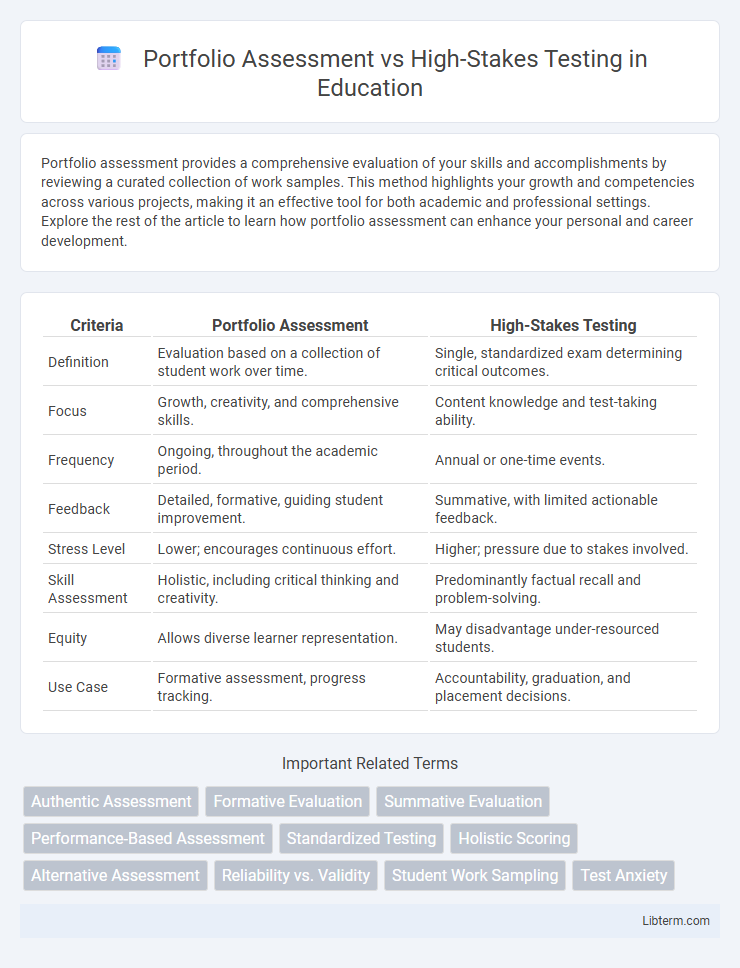Portfolio assessment provides a comprehensive evaluation of your skills and accomplishments by reviewing a curated collection of work samples. This method highlights your growth and competencies across various projects, making it an effective tool for both academic and professional settings. Explore the rest of the article to learn how portfolio assessment can enhance your personal and career development.
Table of Comparison
| Criteria | Portfolio Assessment | High-Stakes Testing |
|---|---|---|
| Definition | Evaluation based on a collection of student work over time. | Single, standardized exam determining critical outcomes. |
| Focus | Growth, creativity, and comprehensive skills. | Content knowledge and test-taking ability. |
| Frequency | Ongoing, throughout the academic period. | Annual or one-time events. |
| Feedback | Detailed, formative, guiding student improvement. | Summative, with limited actionable feedback. |
| Stress Level | Lower; encourages continuous effort. | Higher; pressure due to stakes involved. |
| Skill Assessment | Holistic, including critical thinking and creativity. | Predominantly factual recall and problem-solving. |
| Equity | Allows diverse learner representation. | May disadvantage under-resourced students. |
| Use Case | Formative assessment, progress tracking. | Accountability, graduation, and placement decisions. |
Understanding Portfolio Assessment
Portfolio assessment offers a comprehensive evaluation method by collecting diverse student work over time, providing a deeper insight into learning progress and skills development. It emphasizes qualitative feedback and reflective practices, enabling personalized instruction tailored to individual strengths and challenges. This approach contrasts with high-stakes testing by prioritizing continuous assessment and reducing stress associated with single-exam performance.
Defining High-Stakes Testing
High-stakes testing refers to standardized exams that carry significant consequences for students, educators, or institutions, such as grade promotion, graduation eligibility, or funding allocations. These tests are designed to measure proficiency in core subjects under strict conditions and are often used to make critical educational decisions. High-stakes assessments typically emphasize scores as a primary indicator of performance, contrasting with portfolio assessments, which evaluate a broader range of student work over time.
Key Differences Between Portfolio Assessment and High-Stakes Testing
Portfolio assessment emphasizes ongoing, comprehensive evaluation through diverse student work samples, capturing progress and skill development over time. High-stakes testing relies on standardized, one-time exams that determine vital decisions such as grade promotion, graduation, or teacher evaluation. The portfolio approach fosters formative feedback and individualized learning, whereas high-stakes tests prioritize summative, uniform measurement of performance under strict conditions.
Benefits of Portfolio Assessment
Portfolio assessment offers a comprehensive evaluation of a student's learning progress by showcasing diverse work samples, promoting deeper understanding and critical thinking skills. This method fosters personalized feedback that helps identify strengths and areas for improvement, supporting continuous growth rather than one-time performance. Unlike high-stakes testing, portfolio assessment reduces test anxiety and provides a more authentic representation of a student's abilities over time.
Drawbacks of High-Stakes Testing
High-stakes testing often results in increased student anxiety and a narrowed curriculum focused primarily on test preparation, limiting opportunities for creative and critical thinking. The emphasis on standardized test scores can disproportionately affect marginalized students, exacerbating educational inequalities and reducing overall fairness. This form of assessment also tends to overlook individual learning progress and diverse abilities, providing a limited measurement of student knowledge and skills.
Impact on Student Learning and Motivation
Portfolio assessment fosters deep learning by encouraging continuous reflection and growth, which enhances student motivation through personalized feedback and self-evaluation. High-stakes testing often induces stress and narrows curriculum focus, potentially undermining student engagement and limiting opportunities for creative and critical thinking development. Research indicates that portfolio assessments promote higher-order cognitive skills and sustained motivation, whereas high-stakes tests mainly evaluate rote memorization and performance under pressure.
Teacher and Student Roles in Each Assessment Method
Portfolio assessment emphasizes active teacher involvement in ongoing evaluation, focusing on students' growth, creativity, and critical thinking over time. Students take responsibility for self-reflection, goal-setting, and providing evidence of learning through diverse work samples, fostering deeper engagement and ownership. High-stakes testing positions teachers as facilitators of content delivery aligned with standardized criteria, while students experience pressure to perform on single, summative exams that often limit demonstration of varied skills.
Reliability and Validity: Portfolio vs High-Stakes Testing
Portfolio assessment offers enhanced reliability by providing multiple sources of evidence over time, reducing the impact of performance anxiety and single-test variability. Validity in portfolio assessment is strengthened through diverse, authentic tasks that reflect real-world skills and competencies, unlike high-stakes testing which often measures narrow constructs under artificial conditions. High-stakes testing may demonstrate standardized reliability across large populations but can suffer from validity issues due to limited scope and potential cultural bias.
Equity and Accessibility Considerations
Portfolio assessment enhances equity and accessibility by allowing diverse learners to demonstrate skills through varied work samples, reducing barriers faced by students with different learning styles and language backgrounds. High-stakes testing often exacerbates achievement gaps due to standardized formats that may not accommodate disabilities, cultural differences, or socioeconomic challenges. Implementing portfolio assessments supports inclusive education by providing a more comprehensive and adaptable evaluation method that aligns with individualized learning needs.
Choosing the Right Assessment Method for Educational Goals
Selecting the appropriate assessment method depends on aligning educational goals with the strengths of each approach, where portfolio assessments offer comprehensive insights into student progress through diverse evidence of learning over time. High-stakes testing provides standardized data for comparing performance across wide populations but may not capture individual growth or creative skills effectively. Integrating both methods can optimize instructional strategies by balancing depth of understanding with measurable outcomes.
Portfolio Assessment Infographic

 libterm.com
libterm.com